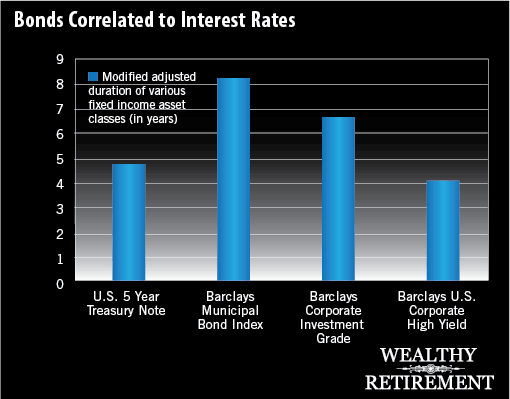 It’s time to set the record straight about bonds, specifically high-yield bonds.
It’s time to set the record straight about bonds, specifically high-yield bonds.
Since the bad ol’ days in the 1980s, when Michael Milken and his cronies at DLJ ruined the reputation of high-yield bonds – that’s where the term “junk bonds” came from – they have been the whipping boy of the industry.
Ask any stock broker and he will tell you these bonds are high risk and to avoid them.
High risk? No way.
[ad#Google Adsense 336×280-IA]Between 1925 and 2005, according to Moody’s, these so-called junk bonds had a success ratio of 94%.
In the current market, the success ratio is 98%.
Smear Campaign
In fact, in this current artificially low interest rate market, all bonds are getting the smear treatment from the stock side of the house.
Analysts – who normally would never attempt to predict what an investment would do, never mind the entire bond market – have been lining up to predict the death of bonds.
Of course, they never bother to specify which bonds, or when, or how much or under what circumstances. They just attack bonds in general. And they have been consistently wrong for the last five years. I don’t expect this track record to change.
Here are the real facts about bonds and interest rate increases.
Just the Facts
Treasurys will show the greatest price decline when interest rates increase. The correlation between interest rates and Treasury prices is almost 100%. When rates do move, Treasurys will be crushed and the longer the maturity the bigger the drop in price.
When the bond market doomsayers talk about bonds being crushed as rates move up, they are talking about the long-maturity Treasurys. But most don’t bother to get that specific.
In fact, every type of bond with a long maturity will drop in price more than ones with shorter maturities. After two years of writing about this for Wealthy Retirement and other Oxford Club publications, I hope this isn’t news to anyone.
But here’s what should be news.
When rates move up, high-yield bonds will have the lowest correlation to Treasurys. That means high-yield bonds will take the smallest hit when Treasurys get crushed. And, as I said before, the high-yield bonds with shorter maturities will see lower drops in value as well.
Take a look at the chart below. It shows the correlation of bond types to interest rate increases.
 Duration is a measure of the price sensitivity of bonds to interest rate changes measured by coupon, maturity and call dates. In other words, the shorter the maturity, the earlier the call dates and the higher the coupon, the lower the duration and the less a bond’s price will react to an increase in interest rates.
Duration is a measure of the price sensitivity of bonds to interest rate changes measured by coupon, maturity and call dates. In other words, the shorter the maturity, the earlier the call dates and the higher the coupon, the lower the duration and the less a bond’s price will react to an increase in interest rates.
And, as you can see, among Treasurys, munis, investment-grade bonds and high-yield bonds, high-yielders have the lowest duration and as such will drop in market value even less than an investment-grade corporate bond.
And keep in mind, this chart is set up with indexes, not individual bonds. The indexes include all maturities, long and short. So, this chart shows a higher duration for all types of bonds than a portfolio of individual bonds will. Limiting maturities to seven years or less can cut the duration of high-yields by an additional 50%.
J.P. Morgan recently reported that over the past 15 years, high-yield bonds actually have a negative correlation of -0.4 to -0.6 to the 10-year Treasury. And investment-grade bonds (those rated BBB and above) have a positive 0.6 correlation to the 10-year.
It sounds crazy, I know, but the numbers don’t lie: High-yield bonds’ negative correlation to Treasurys could potentially improve the stability of the bond portion of your portfolio when rates move up.
The Issuer Matters
Finally, there is one more direct negative correlation between interest rates and corporate bond pricing.
The market value of corporate bonds, both high-yield and investment-grade, is tied more to the issuing company’s balance sheet and credit rating than to interest rates. Not so with Treasurys and munis.
And since rising interest rates are generally associated with an improving economy – and balance sheets generally improve with the economy – credit ratings will improve as the economy does.
For this reason, high-yield bond buyers are concerned with underlying fundamentals and defaults, not interest rates. And defaults decrease in number as the economy, credit ratings and balance sheets improve.
A negative correlation to Treasurys. The lowest duration of all bond types. And improving fundamentals and balance sheets in a rising interest rate environment.
Those are the facts about high-yield bonds and interest rates.
And when you consider high-yields pay the highest rates of virtually all bonds, and they have so much going for them when other bonds will be crushed by rate changes, it is difficult to understand how they ever got such a bad reputation.
Take a look at high-yield bonds. They can offer more income, safety, stability and capital gains than their reputation might lead you to believe.
— Steve McDonald
[ad#sa-income]
Source: Wealthy Retirement


